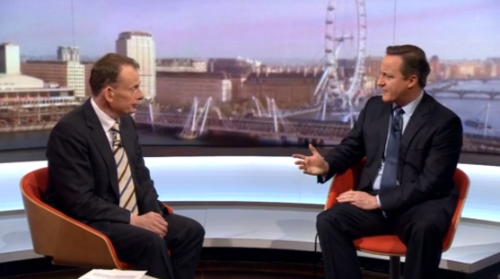Cameron’s sovereignty plan: what to hope for, and what to fear
 David Cameron’s EU deal has been published. But there’s a missing piece of his jigsaw: a “sovereignty plan” that he hoped would reassure waverers like Boris Johnson. On today’s Andrew Marr show, the Prime Minister hinted at what this plan might be (from 49 minutes 10 seconds into the programme; a sound recording is here).
David Cameron’s EU deal has been published. But there’s a missing piece of his jigsaw: a “sovereignty plan” that he hoped would reassure waverers like Boris Johnson. On today’s Andrew Marr show, the Prime Minister hinted at what this plan might be (from 49 minutes 10 seconds into the programme; a sound recording is here).
He told Marr that
we’re going to set out in the coming days proposals … to make clear that … the British Parliament is sovereign. We have chosen to join the EU, we could choose to leave the EU, and I think there’s some important work to put that point beyond doubt …
Marr (who quizzed Cameron on the right legal points) put to him that the UK can’t just “declare UDI” from EU law. He replied that
What you can do … is just put beyond doubt in people’s minds, because sometimes this is questioned … that in the end what our Parliament does, our Parliament can undo; it is a sovereign Parliament …
He declared that—
I am passionate, and love the institutions and the constitution we have in our country …
which is nice but surprising, given Cameron’s history of self-serving constitutional whimmery, such as his demand for compulsory elections after a change of PM, which was flatly contradicted by his awful Fixed-term Parliaments Act; and such as his ongoing support for a wrong-headed “British Bill of Rights”, and recently his government’s spiteful attack on the House of Lords for acting constitutionally over tax credits. The PM has proved himself no conservative on the constitution, or great lover of it.
But back to sovereignty. Asked if he might empower the UK Supreme Court to restrain the European Court of Justice, Cameron said
there is this argument, which our proposals will address, that countries that have written constitutions have sometimes been able not only to assert the sovereignty of their own Parliament … but actually to go further and say that those constitutional principles have to be taken into account.
Finally, asked if he’s proposing a written constitution, Cameron replied
I’m not making that argument. I think we shouldn’t have to do that in order to give to ourselves what some other countries have managed inside the EU—no, I don’t think that’s necessary …
which is a relief. A written constitution would not preserve Parliamentary sovereignty, but end it. So we’ll avoid the worst.
Cameron may simply want some re-restatement that Parliament is sovereign. I say “re-restatement” because it wouldn’t be the first time he’s induced Parliament pointlessly to restate its own sovereignty. Here’s what I wrote about that nonsense at the time.
But it also seems that Cameron has swallowed the myth that other countries—no doubt he means Germany, whose constitutional court is envied by some—are more insulated from EU law than Britain. We must remind ouselves of the basic, telling constitutional fact: there is no Parliamentary sovereignty in Germany. So when Cameron said other countries
have sometimes been able … to assert the sovereignty of their own Parliament
he was flatly wrong. If any EU member state has Parliamentary sovereignty to assert, it’s not Germany. Germany’s parliament is subordinate to its written constitution, the Grundgesetz (here in the Bundestag‘s own English translation). This is clear from article 1(3), which introduces articles 2-19 (in essence Germany’s “bill of rights”) and says
The following basic rights shall bind the legislature …
and article 20(3), which says
The legislature shall be bound by the constitutional order …
Parliamentary sovereignty is the direct opposite: it means Parliament is not bound by any higher law. How can we preserve Parliamentary sovereignty by copying a country that rejects it?
What the PM overlooks is that assertive noises come from the German court because it, not the Bundestag, has prime constitutional power. Indeed, the court limits what the federal parliament may assent to in Europe. The German court’s power, in other words, comes at the expense of its parliament.
They are only noises, by the way: there is no example of an EU law that Britain obeys and Germany rejects.
If German judges ever refuse to implement EU law, there’ll be a legal crisis. The ECJ could fine Germany; someone might have to give way; or else a solution would be found by politicians to satisfy both sides. But it’d be just the same if Britain rejected an EU law. The ECJ might fine us; a solution might have to be found satisfying both the ECJ and Parliament.
Parliamentary sovereignty means that in Britain it is Parliament that reserves the right to reject EU law—not a constitutional court—and Parliament that has ultimate primacy. So Britain is already in exactly the same constitutional relationship to the EU as Germany. The difference is that we have a sovereign Parliament, while Germany has a sovereign written constitution guarded by its constitutional court. Germany’s apparent extra safeguard is an optical illusion.
If a German mirage leads the PM to empower our own judges, that power may well one day be turned on Parliament. Our top judges were relabelled a “Supreme Court” not long ago; they’ve been urged to assert themselves against the European Court of Human Rights, and are already doing so against EU law. If you dress them up further as a “constitutional court” and give them new powers to declare things in breach of a fundamental or embryonic written constitution (such as a “bill of rights”), they might soon see themselves as our constitution’s
ultimate controlling factor … defining the limits of Parliament’s legislative sovereignty
to adapt Lord Hope’s words in Attorney General v Jackson in 2005 (para. 107). They might even feel emboldened to qualify Parliamentary sovereignty as having been
established on a different hypothesis of constitutionalism
to quite Lord Steyn’s notorious words in the same case (para. 102). Our constitution really would start to resemble Germany’s, and Parliamentary sovereignty as we know it would be finished.
If conservatives, of all people, end up empowering judges against Parliament, they’ll bitterly regret it. Anyone who really loves the British constitution should fear this plan, and hope it’s anodyne.

